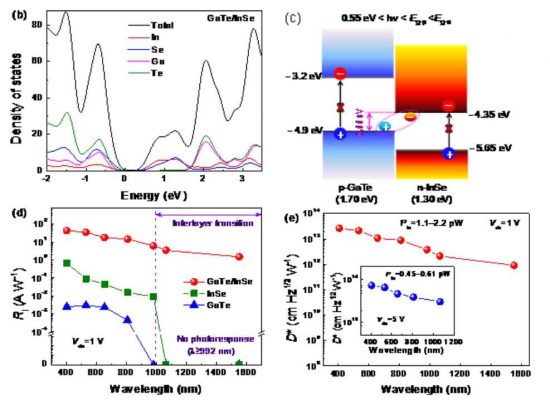Research by an interdisciplinary team in Shenzhen is heading down the path towards cheaper and more environmentally friendly photodetectors, potentially revolutionizing imaging and remote sensing. A recent paper by Southern University of Science and Technology (SUSTech) has successfully investigated the use of two-dimensional layers to develop a new type of uncooled photodetector.
The collaborative efforts of teams from SUSTech’s Department of Physics and Department of Electronic and Electrical Engineering (EEE) saw a paper published in Advanced Functional Materials (IF = 15.621). Associate Professors Zhang Liyuan (Physics), Gong Youpin (Physics), and Chen Rui (EEE) were the co-correspondent authors on the paper titled “Interlayer Transition in a vdW Heterostructure toward Ultrahigh Detectivity Shortwave Infrared Photodetectors.”
SWIR photodetectors are widely used in remote sensing, imaging, and free-space communications. However, commercial-grade SWIR photodetectors tend to use highly toxic chemicals such as mercury (Hg), cadmium (Cd), and arsenic (As). Other chemicals include tellurium (Te), iridium (In), gallium (Ga), and antimony (Sb). The compounds formed from these elements can also struggle to create a uniform structure, or offer a low yield. In some cases, they must operate at a low temperature to ensure high efficiency. There are also examples of conventional SWIR photodetectors requiring highly expensive equipment for their fabrication. Thus, a new uncooled and high-performance SWIR photodetector that is cheap and easy to manufacture is vital for the industry.
The research team studied GaTe/InSe van der Waals (vdW) type II semiconductor heterojunctions. They applied 2D layered material (2DLMs) vdW heterojunction band engineering, which saw a smaller band-gap and improved photodetection. Their research found that the band-gap reduced from ~1.3 eV to ~0.5 eV, reflecting significantly improved detection capacity at the 1.0–1.55 μm band. These results are comparable to the most recent commercial models.
The most crucial point is that 2DLMs vdW heterojunctions with a new mechanism can provide a feasible new strategy for developing high-performance SWIR devices. There is potential for their application in longer wavelengths, which would surpass previous limitations of the constituent atomic layers in the field. It is also possible that this new development could lead to flexible optoelectronic devices.


Figure 1: Device structure and photodetection performance. (A) 3D device structure diagram; (b) Total and partial (based on atomic types) density of states in the GaTe/InSe heterojunction; (c) GaTe/InSe type II energy schematic diagram of band arrangement; (d) Responsivity as a function of the wavelength obtained in the GaTe/InSe vdW heterostructure (red) and individual InSe (olive) and GaTe (blue) devices. (e) D* as a function of the wavelength obtained at Vds = 1 V and Vds = 5 V (inset).
Research Assistant Qi Tailei and Research Associate Professor Gong Youpin were the co-first authors of the paper. Professor Judy Z. Wu of the University of Kansas and Professor Ridwan Sakidja of Missouri State University also made vital contributions to the research. Other contributing institutions included the Shenzhen Institute for Quantum Science and Engineering (SIQSE) and the Beijing National Laboratory for Condensed Matter Physics and Institute of Physics, Chinese Academy of Sciences (CAS).
The work was supported by the Shenzhen Science and Technology Innovation Commission, the Guangdong Innovative and Entrepreneurial Research Team Program, the National Natural Science Foundation of China (NSFC), the Shenzhen Science and Technology Innovation Commission, the US National Science Foundation and the United States Army Research Office.
Article link (Adv. Funct. Mater. 2019, 1905687):
https://onlinelibrary.wiley.com/doi/full/10.1002/adfm.201905687
Proofread ByXia Yingying
Photo ByDepartment of Physics